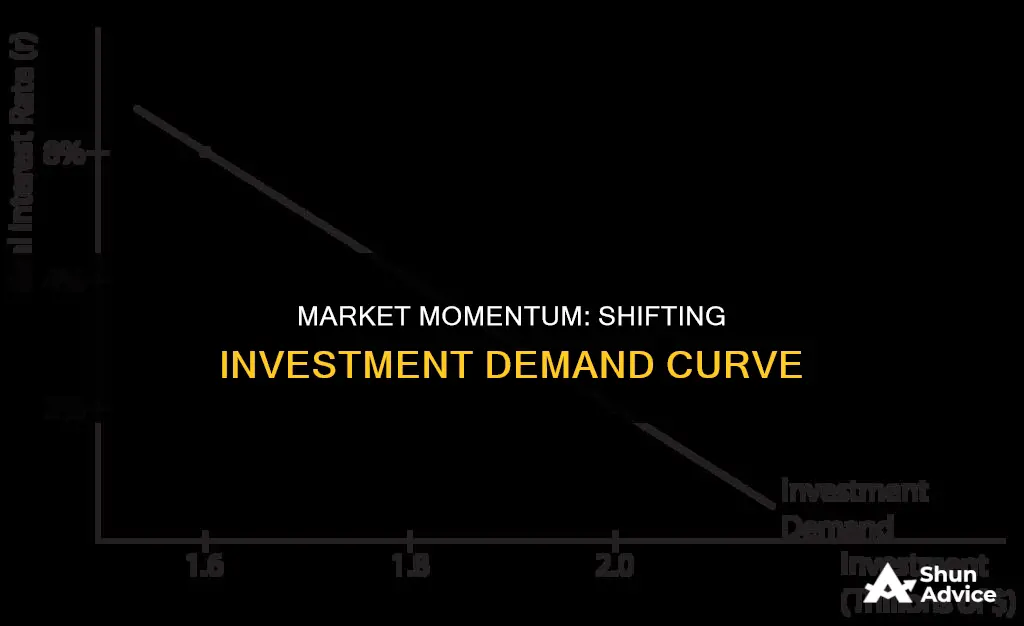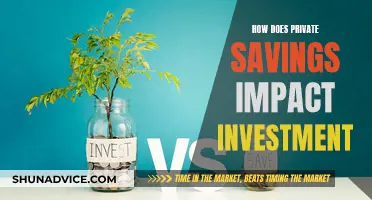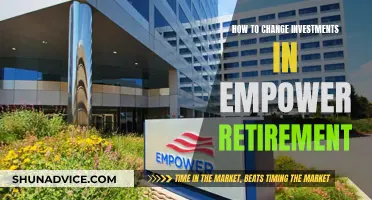
The investment demand curve will shift to the right when expectations change in a way that increases the expected return from investment. This could be influenced by a rise in business or consumer confidence, which is often associated with a growing economy. An increase in the level of economic activity, such as GDP, can also lead to a rightward shift in the investment demand curve.
Additionally, firms planning to increase their inventories for future needs will cause the curve to shift to the right. This is because investment decisions are associated with planned investment, and increasing inventories will raise investment demand.
Furthermore, a decrease in the cost of capital goods or a technological breakthrough that creates prospects for profitable new products can also shift the curve to the right.
| Characteristics | Values |
|---|---|
| Expectations of future profitability | Increase |
| Level of economic activity | Increase |
| Stock of capital | Increase |
| Capacity utilization | Increase |
| Cost of capital goods | Decrease |
| Other factor costs | Increase |
| Technological change | Increase |
| Public policy | Increase |
What You'll Learn

Higher government spending
The relationship between government spending and the shift in the investment demand curve can be understood through the aggregate demand and aggregate supply model (AD-AS model). This model illustrates the interaction between total supply and total demand in an economy and how changes in government spending can impact the equilibrium quantity of output and the price level.
When the government increases its spending, the AD curve shifts to the right. This shift indicates an increase in aggregate demand, which can be caused by various factors such as higher consumer and business confidence, changes in government policy, or improvements in the economic outlook. As a result of this shift, the equilibrium quantity of output and the price level will rise.
On the other hand, if government spending decreases, the AD curve will shift to the left, indicating a decrease in aggregate demand. This leftward shift will lead to a decrease in both the equilibrium output and the price level.
It is important to note that the impact of changes in government spending on the investment demand curve may vary depending on the current state of the economy. For instance, during a recession, when the economy is operating below its potential output and unemployment is high, an increase in government spending can stimulate economic activity and help boost aggregate demand. However, if the economy is already performing well and is close to its full employment level, an increase in government spending may lead to inflationary pressures without a significant increase in GDP.
Additionally, the impact of government spending on the investment demand curve can be influenced by other factors, such as tax policy. For example, tax cuts for individuals can increase consumption demand, while tax increases can reduce it. Similarly, tax policies that offer lower tax rates for corporations or specific types of investments can stimulate investment demand.
In summary, higher government spending has the potential to shift the investment demand curve to the right by increasing aggregate demand and shifting the AD curve to the right. This, in turn, leads to an increase in the equilibrium quantity of output and the price level. However, the specific effects may vary based on the economic context and the interaction of other factors, such as tax policies and the business cycle.
The Enterprise's Next Big Bet: Unlocking the Power of AI
You may want to see also

Tax cuts for individuals
During a recession, when unemployment is high and many businesses are suffering losses, the US Congress often passes tax cuts to stimulate the economy. The tax cuts increase consumption, shifting the AD curve to the right. At the new equilibrium, real GDP rises, unemployment falls, and there is little to no rise in the price level.
However, the effectiveness of tax cuts depends on the state of the economy. When the economy is already doing well and unemployment is low, tax cuts may shift the AD curve too far to the right, generating inflationary pressures with little gain in GDP.
Additionally, the impact of tax cuts also depends on whether they are accompanied by equivalent reductions in government spending. Economists have differing opinions on the optimal level of government spending and which programs should be cut back.
Teaching Retirement: Navigating the Investment Maze
You may want to see also

Expectations of higher future sales
The relationship between expectations and investment decisions can be observed in various sectors. For instance, in the residential housing market, low-interest rates are often reported to stimulate construction activity, indicating a positive relationship between low-interest rates and investment in this industry. Similarly, expectations of higher future sales in the housing market can incentivize developers to initiate new projects, anticipating robust demand and profitable returns.
The same principle applies to government agencies and their investment decisions. Public sector entities may be encouraged to increase their investment in public capital, such as transportation and education infrastructure, when they foresee higher future sales or revenue. This could be a result of anticipated economic growth, favourable market conditions, or effective policy interventions.
Moreover, expectations of higher future sales can also influence the investment choices of private firms and individuals. For example, a company may decide to invest in a new technology or expand its production capacity if it foresees increased demand for its products. This decision would be based on optimistic sales projections and the expectation of higher future revenue.
It is worth noting that while expectations of higher future sales can shift the investment demand curve to the right, changes in other factors, such as interest rates, economic activity, and public policy, can also play a significant role in driving investment choices. These factors collectively shape the investment landscape and influence the direction of the investment demand curve.
Corporations and Their Overseas Investments: Strategies for Excess Capital
You may want to see also

Technological advances
Increased Investment Demand
Technological advancements often spur investment as businesses seek to enhance their operational efficiency and competitiveness. The integration of new technologies may require substantial investments in equipment and processes, leading to an outward shift in the investment demand curve. This indicates an increase in investment demand at each interest rate level.
Enhanced Productivity and Returns
The adoption of innovative technologies can boost productivity and profitability for businesses. For example, technological advancements in computers, telecommunications, and manufacturing processes have encouraged massive investments. As businesses recognize the potential for higher returns, they become more inclined to invest, resulting in a rightward shift of the investment demand curve.
Reduced Production Costs
Technological advancements can drive down the input costs of production. For instance, improvements in manufacturing processes or the introduction of automation may lower operating expenses, making it more financially viable for businesses to increase their investment in physical capital. This shift in the curve reflects the increased quantity of investment demanded at various interest rates.
Market Expansion and Consumer Demand
Technological innovations can create new markets and increase consumer demand. For example, the emergence of tablets as a competitor to laptops influenced a shift in consumer preferences and reduced the demand for laptops. This shift in demand can prompt businesses to adjust their investment strategies, potentially leading to a rightward movement of the investment demand curve.
Government Incentives
Governments may introduce policies to encourage the adoption of new technologies, such as tax breaks or investment incentives. These measures can influence businesses to increase their investment in technological advancements, resulting in a rightward shift of the investment demand curve.
Overall, technological advances play a pivotal role in shaping the investment demand curve. They drive investment decisions by offering opportunities for enhanced efficiency, productivity, and market competitiveness. As businesses recognize the potential benefits, the investment demand curve shifts to the right, indicating increased investment demand across different interest rate levels.
Investment Exploration: Uncovering Alternative Strategies Beyond Retirement Planning
You may want to see also

Lower interest rates
When interest rates are low, borrowing becomes cheaper, and the cost of capital is reduced, making investments more affordable. This is especially beneficial for investments that require a large amount of capital upfront, such as new plants, capital equipment, machinery, and construction. With lower interest rates, businesses can also take on more debt without significantly increasing their financial risk.
Additionally, lower interest rates can increase firms' demand for capital. This is because capital is a factor of production, and when interest rates are low, it becomes more attractive for firms to invest in capital-intensive projects. For example, a factory may choose to use sophisticated capital facilities and relatively fewer workers when interest rates are low, as it becomes more cost-effective to invest in capital rather than labor.
Overall, lower interest rates can increase the number of potential investments that are justified, leading to a shift in the investment demand curve to the right.
Young Investors: CDs Worth It?
You may want to see also
Frequently asked questions
The investment demand curve shows the volume of investment spending per year at each interest rate, assuming all other determinants of investment are unchanged. The curve illustrates the inverse relationship between the interest rate and the level of investment.
Changes in interest rates, expectations, the level of economic activity, the stock of capital, capacity utilisation, the cost of capital goods, other factor costs, technological changes, and public policy can all cause the investment demand curve to shift.
A shift in the investment demand curve can cause a shift in the aggregate demand curve. An increase in investment demand will shift the aggregate demand curve to the right, and a decrease in investment demand will shift the aggregate demand curve to the left.
Higher interest rates tend to reduce the quantity of investment, while lower interest rates increase it. A reduction in interest rates will cause a rightward shift in the investment demand curve.
If expectations change in a way that increases the expected return from investment, the investment demand curve will shift to the right. Similarly, expectations of reduced profitability will shift the curve to the left.







